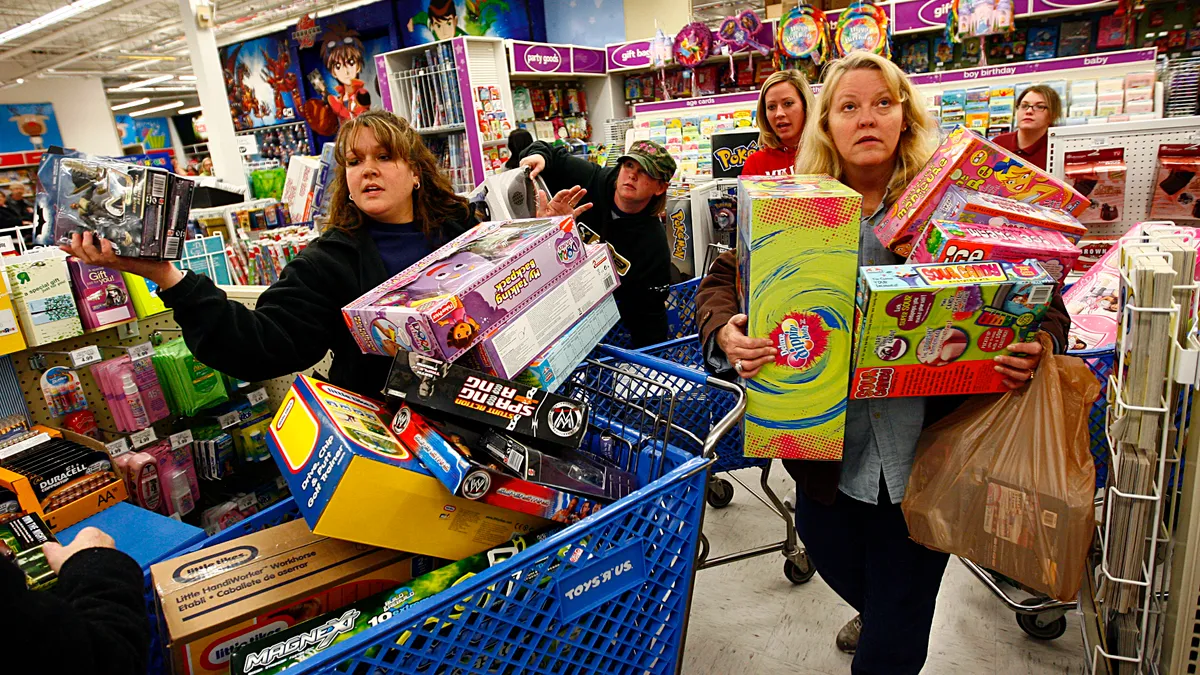Dive Brief:
- Retail sales rose 0.7% in July, increasing for the fourth consecutive month as shoppers stepped up spending following several weeks of disinflation, solid wage gains and high demand for workers.
- Bars and restaurants, clothing stores, food and beverage stores, and six other retail categories registered higher sales last month, while business at furniture, motor vehicle and electronic stores declined, the Commerce Department said Tuesday. Sales by e-commerce and other nonstore retailers surged 1.9% during the month and 10.3% compared with July 2022.
- “We looked at 2023 as a year of moderation after the explosive growth we had the prior few years and, as we called out, consumers would be shifting their spending from goods to services,” Home Depot CEO Edward Decker said Tuesday during the company’s quarterly earnings call. “While that shift is happening, the overall economy and the consumer in particular, have remained incredibly resilient.”
Dive Insight:
Several forces, such as an unusually low 3.5% unemployment rate and a 0.3% increase in real hourly wages last month, have fueled consumer spending despite rising borrowing costs, a decline in pandemic-period savings, the end of child tax credits and the coming end of a moratorium on student loan payments in October.
In recent weeks many private- and public-sector economists — including those at the Federal Reserve — have either hedged or abandoned recession forecasts.
“We are all reading the same data you are about the potential for a soft landing for the U.S. economy,” Etsy CFO Rachel Glaser said during an Aug. 2 earnings call, referring to the possibility that the Fed’s most aggressive monetary tightening in four decades will not prompt widespread unemployment and recession.
Economic data supports predictions that consumer spending will increase during the second half of 2023, Mattel CFO Anthony DiSilvestro said in the company’s quarterly earnings call. “Unemployment remains low, inflation seems to be subsiding and consumer sentiment seems to be on the rise.”
Consumers have steadily grown more confident, according to a consumer sentiment survey by the University of Michigan. When viewing the economy, consumers “saw substantial improvements relative to just three months ago,” survey director Joanne Hsu said Friday in a statement.
Still, consumer discretionary spending confronts “stiff headwinds,” especially among buyers with annual incomes below $100,000, Glaser said.
Ralph Lauren also faces the prospect of reduced spending by lower-income customers, CFO Jane Nielsen said during the company’s Aug. 10 earnings call.
“In our channels with exposure to value-oriented consumers — notably outlet — inflation continues to pressure consumer spending,” she said.
Looking ahead, Shake Shack is balancing high inflation and a cloudy outlook for consumer spending against “strong underlying business factors” during the first half of 2023, CFO Katherine Fogertey said during the company’s Aug. 3 earnings call.
“Beef inflationary risks are real and present a headwind to our profitability through the rest of the year,” she said. “However, all else equal, if beef inflation was consistent with last year's performance and consumer spending patterns remain strong, we see a path for our restaurant margins to exceed 20% for the full year.”
DoorDash foresees robust customer spending after reporting an increase in market share in its core restaurant business as well as in categories including grocery, retail and office supplies.
“Obviously, consumer spending continues to be strong, the underlying cohorts continue to be stable,” DoorDash CFO Ravi Inukonda said during the company’s Aug. 2 earnings call.
At Mattel, popularity of the Barbie movie has given optimism about consumer spending for the remainder of 2023 a distinctive pinkish glow.
“Following the incredibly successful Barbie movie release, we look forward to capitalizing on the many exciting opportunities to capture the full value of our iconic brands outside the toy aisle,” CEO Ynon Kreiz said during the company’s July 16 earnings call.
“Mattel outperformed the industry and gained over 400 basis points of market share in the dolls category year-to-date,” he said. “And Barbie was the No. 1 doll property globally.”
“The biggest shift in our strategy, and in our DNA, was to realize that people who buy our product are not just consumers, they are fans,” Kreiz said.













